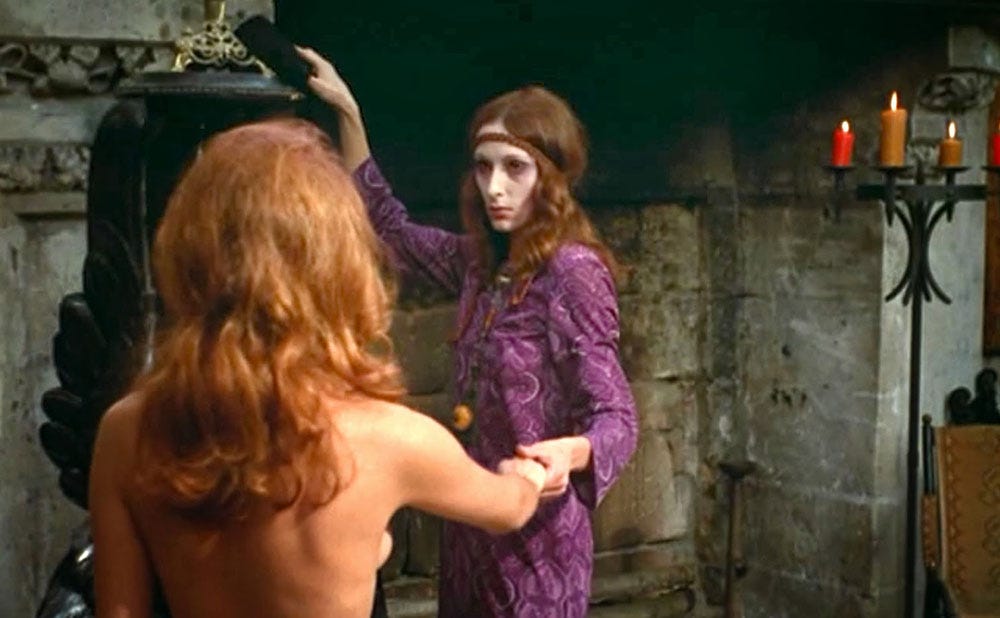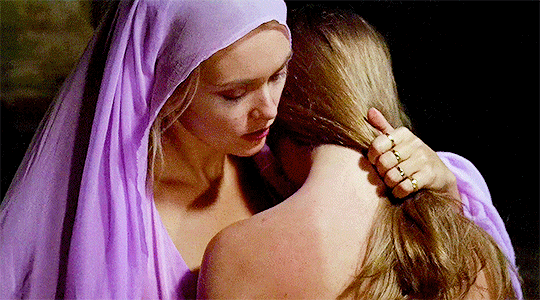A couple of years ago, I worked on one of the most interesting shows I’ve ever been a part of. It was called Queer for Fear, and it’s a doc series on the history of horror told through a queer lens. I directed the fourth and final episode, which traced the trope of the dangerous queer woman through horror history.
One of the subjects we explored was the strange boom of lesbian vampire exploitation films in the 1970s—a moment when horror cinema became a mirror for both erotic fantasy and male anxieties.
If you’re not familiar with these films, they’re pretty great in a grindhouse/ exploitation kind of way. Some lean towards the arthouse or experimental space, like Roger Vadim’s Blood and Roses (made in 1960 so this one’s actually more of a precursor to the exploitation boom) and, to a lesser extent, Jesús Franco’s Vampyros Lesbos (1971), and others pretty much veer towards straight up porn, like Franco’s Female Vampire (1975).
The explosion of these films emerged on the heels of the second-wave feminist movement and post-Stonewall gay rights movement, and, I’d argue, can be viewed as a backlash against both. It was an era of seismic social change that threatened the patriarchal order, and as a result, birthed a new villain: the liberated—and deadly—lesbian vampire.
Where earlier films like the pre-code campy classic Dracula’s Daughter (1936), depicted female vampires as repressed and trying to sublimate their desire to feed, the 1970s vampires fully embraced their nature.
Almost all of the 1970s lesbian vampire films were directed by men—the only one I know of that was directed by a woman is Stephanie Rothman’s The Velvet Vampire (1971)—and designed for the male gaze.
These films, like Vampyros Lesbos, Jean Rollin’s Shiver of the Vampire (1971), Roy Baker’s The Vampire Lovers (1970), and Vicente Aranda’s The Blood Spattered Bride (1972), feature super stylish and hot femme vampires who seduce women and lure them away from their male partners—in other words, they embody the trope of the “dangerous lesbian” or “shifty bisexual.” Men are simultaneously titillated and horrified by the lesbian vampire because she’s a woman whose desire exists outside of their control.
The bite of the vampire is a penetrative act, so we can view the female vampire’s bite as an inversion of the sexual script in which men are the ones who enter, dominate, and consume. Scenes of feeding are filmed with fetishistic intensity—the camera lingering on the neck, the mouth, the moment of surrender. The vampire’s teeth become a kind of erotic weapon, and to the male imagination, this reversal of sexual agency is horrifying.
A scene towards the end of The Blood Spattered Bride explicitly states these fears: the vampire Carmila urges newlywed Susan to stab her husband, yelling, “Kill him! Put an end to his arrogance! Destroy his masculinity!” We can link this to male anxieties around liberated women in general, and queer women in particular. The lines feel like an echo of second-wave rhetoric refracted through male paranoia — the women’s movement becomes literalized as bloodlust.
The trope of the new bride being corrupted by the vampire comes up in a bunch of these films, including The Shiver of the Vampire (which btw has some of the most iconic and absurd visuals, like the vampire emerging from a grandfather clock and popping out from behind a tapestry hanging over a bed). We can view this as a metaphor for a queer sexual awakening — these women think they’re straight until they have an encounter with the lesbian vampire. The lesbian vampire, then, is a projection of the nightmare that women might not need men at all.
In many of these films, the vampires are able to visit the women in their dreams, where they can kind of mind control and lure the women towards them. I think this speaks to a male fear of women’s intuition. In Vampyros Lesbos, for example, Linda dreams of the vampire Nadine, who telepathically draws Linda to her island home, where she seduces and feeds on her.
Vampyros Lesbos, like many of these films, is loosely inspired by the story of Elizabeth Bathory, the seventeenth-century Hungarian countess accused of murdering and bathing in the blood of young women to preserve her youth. Historians now question the charges against her, suggesting they were politically motivated—a campaign to destroy a powerful, wealthy widow whose independence threatened the men around her. Her supposed “bloodlust” reads as an allegory for the punishment of female power itself.
There’s so much more I could write about this topic, but alas, this post is already a day late. If you’re interested in the horror trope of the dangerous queer woman and want to know more, you should check out episode 4 of Queer for Fear.
Until next time,
Tara




